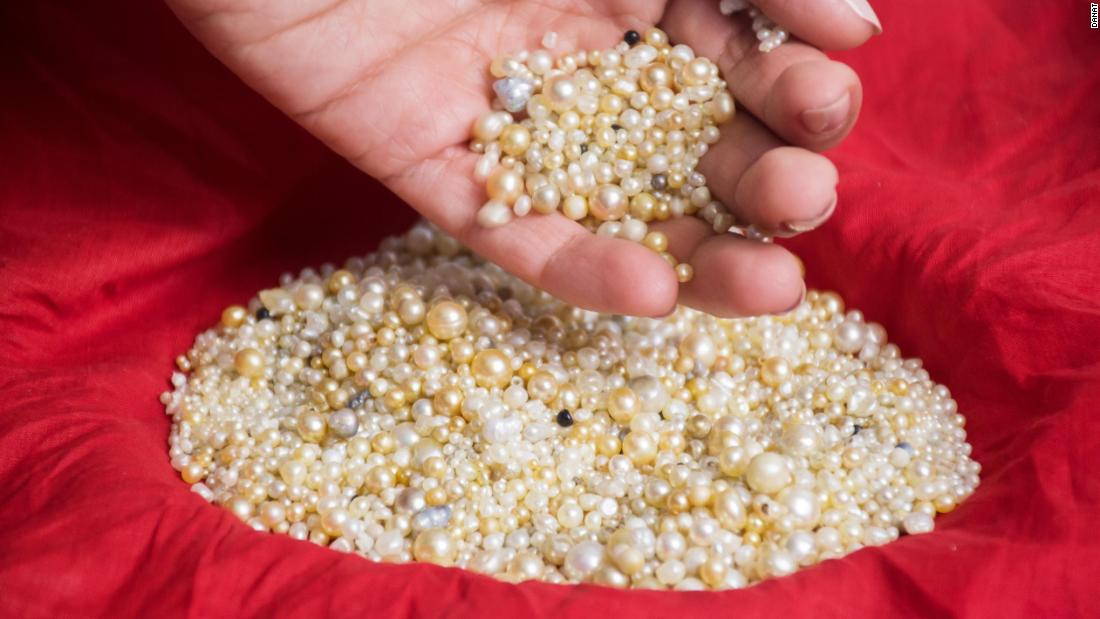“Working in the natural pearl business is one of the toughest jobs, due to the rarity of your star item,” he says.
“Our geographical location as an island in the middle of the trade route from Iraq to India has given Bahrain a significant market for this business,” Mattar says. He adds that some marine biologists believe that the convergence of salt water with cool natural springs in the middle of the gulf creates a unique environment for pearls to grow with high luster.
Although the value of the natural pearl plummeted after the advent of cultured pearls in Japan in the early 1900s, gemstones are experiencing a renaissance as consumers seek more responsibly sourced jewelry and unique pieces.
Natural pearls as “ultra-luxury”
Natural pearls occur when a foreign object – such as a grain of sand or a parasite – gets inside a pearl oyster. To protect itself, the oyster produces an iridescent mineral substance which engulfs the object.
Collection is done in the least intrusive way with licensed divers carefully picking the oysters by hand, says Noora Jamsheer, CEO of the Bahrain Pearl and Gemstone Institute (DANAT), which was established in 2017. to support a national plan to revive the pearl industry.
In conjunction with the Supreme Council for the Environment and the Coast Guard, DANAT monitors and protects the health of the pearl beds, periodically suspending diving in certain areas to allow growth. The institute tests and certifies pearls and offers hands-on pearl grading training.
Although affected by the pandemic, DANAT says the natural pearl market is growing steadily. According to the institute, all parts of the industry in Bahrain have grown over the past year, and 2021 has seen significant growth in the number of pearl diving licenses issued – including, for the first time, licenses granted to female pearl divers.
“We saw a strong rebound in 2021 in luxury market growth,” Jamsheer says. “We’re not talking about the Guccis and the Louis Vuittons; it’s happening in the ultra-luxury, extremely exclusive, one-of-a-kind sector – and that’s where the natural pearls fall.”
Back in style
The biggest challenge for the natural pearl market today is the cultured pearl, says Kenneth Scarratt, chairman of the Pearl Commission of the International Jewelery Confederation (CIBJO).
Scarratt, a world-renowned expert who has worked in the pearl industry for 50 years and helped lead DANAT when the institute was launched, says the collapse in the value of natural pearl was caused by the advent of cultured pearls in Japan, followed by the Great Depression of the 1930s.
“After the Great Depression ended, the cultured pearl trade grew exponentially,” Scarratt says. “The super-rich no longer bought pearls, but cultured pearls were an affordable option for the common person.”
To the untrained eye, cultured pearls are indistinguishable from natural pearls. With natural pearls making millions at auction and their cultured counterpart available for as little as $50, it’s easy to see why consumers would opt for the perfect imitation.
But Scarratt says he’s seen interest in natural pearls rematerialize over the past decade. “There is a growing segment of the market that is looking for the rare. This segment of the market is looking for natural pearls,” he explains.
Scarratt says most of the beads found in Bahrain are “seed beads”, small beads used in intricate jewelry designs and high fashion clothing. “They look particularly good,” he adds.
These Bahrain seed pearls are in demand again as new jewelry houses emerge and established jewelers begin to reinvent natural pearls in contemporary designs.
“Generations that came after the birth of cultured pearls, who weren’t exposed to natural pearls, don’t necessarily know the difference between a cultured pearl and a natural pearl,” says Mattar. “Our greatest goal is to educate the world about the alluring beauty of the natural pearl, especially Bahrain pearls, by introducing new concepts and creating world-class jewelry that instills a love of this gem.”

